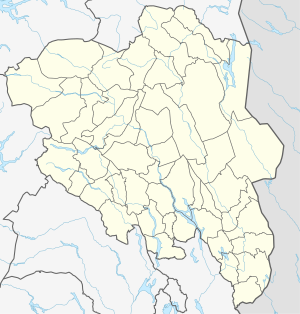Femundsee
| Femund | ||
|---|---|---|

|
||
| Femund | ||
| Geographical location | Border Fylke Innlandet / Trøndelag , Norway | |
| Tributaries | roe | |
| Drain | Glöta → Isteren → Trysilelva (also Klarälven ) → Vänern → Göta älv | |
| Data | ||
| Coordinates | 62 ° 10 ′ N , 11 ° 54 ′ E | |
|
|
||
| Altitude above sea level | 662 moh. | |
| surface | 203.52 km² | |
| length | 60 km | |
| width | 5 km | |
| volume | 6 km³ | |
| Maximum depth | 231 m | |
The Femundsee ( Norwegian Femund ) in the Femundsmarka of the same name is an approx. 60 km long and up to 5 km wide north-south running lake in a valley parallel to the Glåma valley (at the height of Alvdal ) in central Norway . It is mainly in Fylke Innlandet , while the northern part is in Fylke Trøndelag .
geography
The Femund is fed by many small rivers, as the main source of the river is considered by the Swedish Härjedalen coming roe . The outflow on the southern tip of the lake is the Glöta, which flows into the Isteren after just 2 km . The water flows further into the Trysilelva , which is called Klarälven downstream on Swedish territory .
history
Because of the unfavorable living conditions, the area around the Femundsee was settled very late. In the 17th century, Sami came from Finnmark to graze their reindeer herds here . After rich copper ore deposits were found around Røros in 1644 , their systematic mining began as early as 1645. Both for the fire blasting of the rock underground, as well as for the smelting of the mined ore, large amounts of firewood were required, which were obtained in the forests around the Femund. The lake was dammed so that the tribes could be floated to Røros.
From 1742 to 1833 there was the settlement Femundshytta on the west bank with a steelworks that processed the copper ore from the pits around Røros about 70 km away. By transporting the ore, it was possible to save the volume of the not inconsiderable transport of the required firewood to Røros and also to deposit the slag in a decentralized manner. At that time, around 300 forest workers, charcoal burners and smelters lived in the village . Today only ruins bear witness to that time.
From 1986 the area around the lake was at times relatively heavily contaminated by the Chernobyl disaster through radioactive fallout (up to 15,000 Becquerel cesium 134 + 137 per square meter).
Flora and fauna
The area east of the lake on the border with Sweden is part of Femundsmarka National Park , where lynxes , wolverines , minks, martens and the occasional brown bear can be seen. However, the beaver area near Røhlen on the north-eastern shore of the lake is particularly well-known and relatively easy to reach . Near Elgå , a group of seeds near the east bank grazes around 3,000 tame reindeer. There are large areas of reindeer lichen around the lake ; These shrub lichen are an important part of the reindeer food in the winter months, but are also collected there by the locals and sold abroad. In Germany u. a. Use for flower arrangements for the Sunday of the Dead . A musk ox herd has been in the area east of the lake since 1984 .
tourism
A passenger ship called “ Fæmund II ” runs between Synnervika and Elgå in the summer months , which in the past even took one or two cars and cows with it and still takes care of residents and tourists and brings visitors to the scenic destinations of Femundsmarka National Park. Canoe wilderness tours on the lake are also popular, but they are not without risk due to the sometimes erratic weather changes and the falling winds that occur.
At the southern end of the lake in Drevsjø is the Blokkodden open-air museum , which explains the life of the Sami and the coexistence of Sami and Norwegians since the 17th century. The only inland fish market in Norway is located in Elgå.
See also
literature
- Jens Finborud (Redaktør): Femunden. Innlandshavet ved Norges austgrense . Norwegian and English. Västerås 1985
- The Norske Turistforening : Femundsmarka . Oslo 1987, ISBN 82-90339-20-8
- Norbert Wehrmann: Fermundsee and Röa . In: Canoeing in Europe . tape 7 . SYRO-Verlagbuchhandlung, Göttingen 1984, ISBN 3-921885-97-3 , p. 91 .
Web links
Individual evidence
- ↑ Gerd Kassel: "Canoe tours in Canoeing Femund", Pollner Verlag, 1999, ISBN 978-3-925660-79-5
- ↑ Halvor Aarnes: Tsjernobyl-ulykken og Femundsmarka . In: Den Norske Turistforening: Femundsmarka . Oslo 1987, p. 180 ff
- ↑ Arne Kraft: Dyret fra urtiden . In: Den Norske Turistforening: Femundsmarka . Oslo 1987. p. 126 ff


